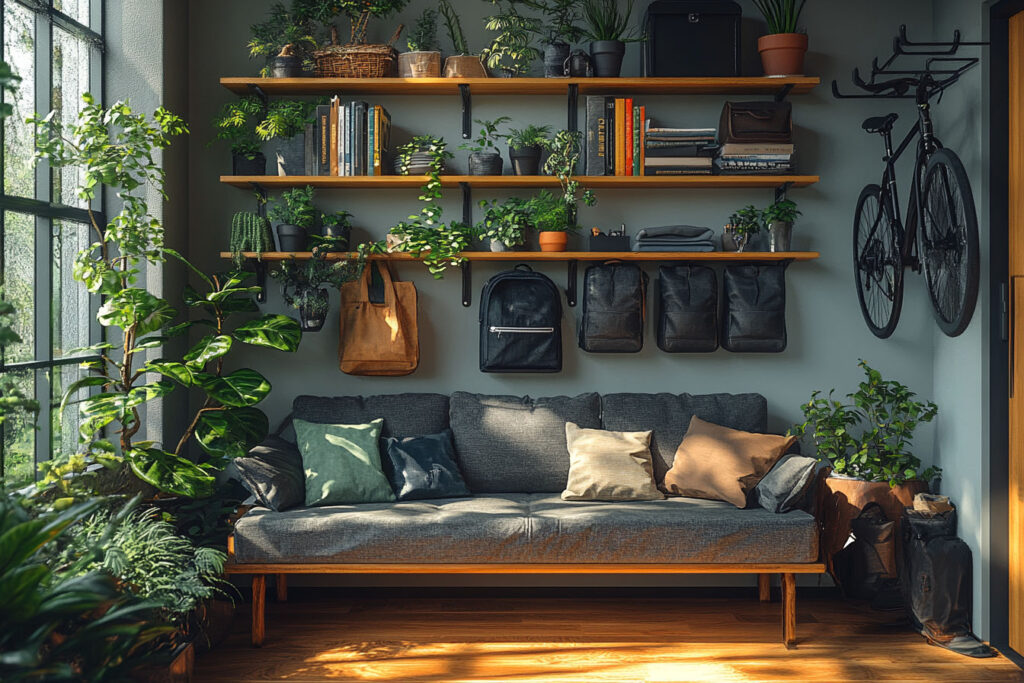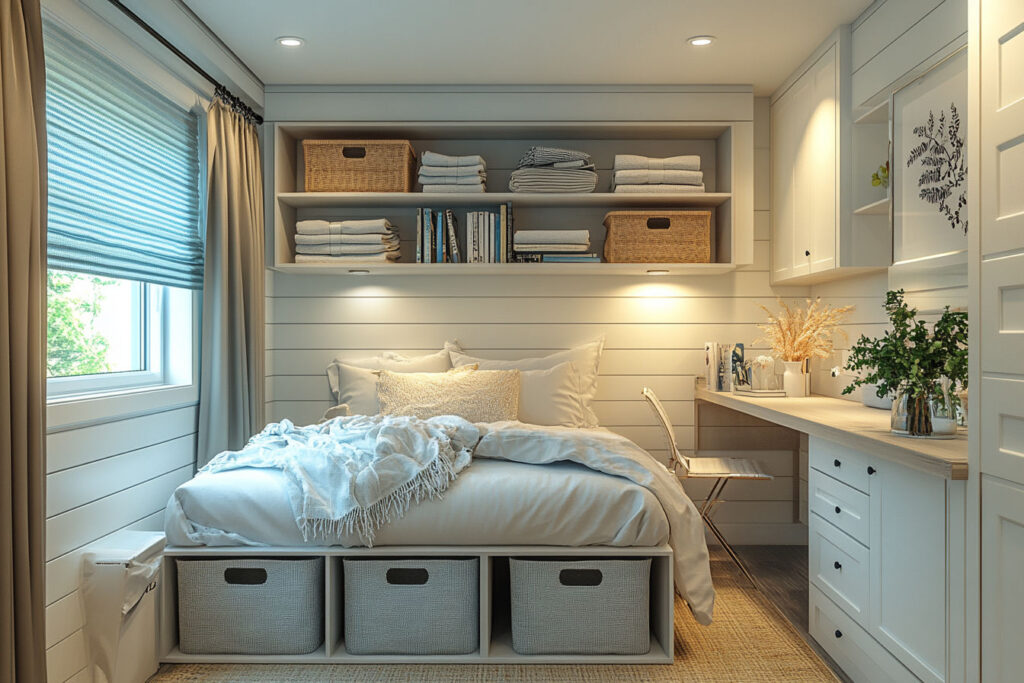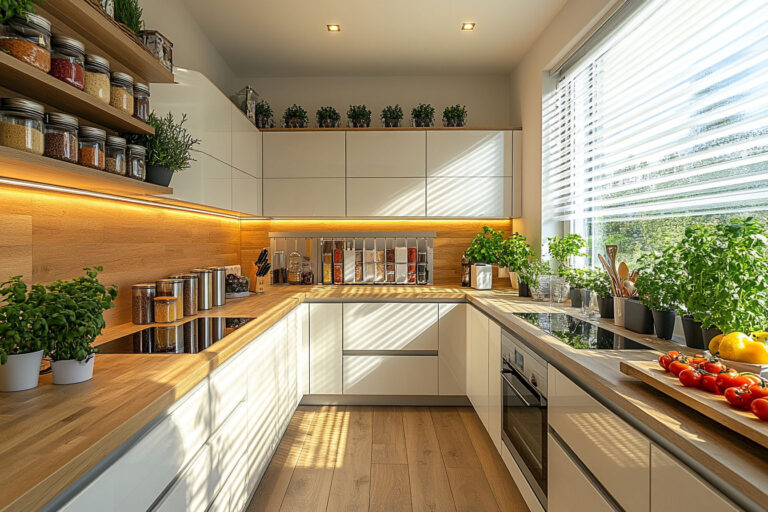This post may contain affiliate links. If you make a purchase through these links, we may earn a commission at no additional cost to you.
Small homes pepper the American landscape, from Seattle’s sleek apartments to Austin’s cozy bungalows, where the average pad clocks in under 2,200 square feet. Space shrinks fast in these urban and suburban nests—closets overflow, counters vanish, and clutter creeps into every corner. It’s not just a hassle; it dims the vibe of rooms meant for crashing, cooking, or catching up. But tight quarters don’t have to win. Smart storage solutions flip the script, turning cramped chaos into organized calm with tricks that fit any budget or lease.
Unlock the Best Storage Solutions for Small American Homes
This article cracks open the best fixes for small American homes, spotlighting vertical hacks, multi-use furniture, hidden nooks, and modular magic. Rent a studio? Own a fixer-upper? These ideas stretch every inch—think wall shelves swallowing books or beds hiding gear—proving you don’t need more space, just better moves.
Why Small Homes Rule the U.S.
Half of U.S. homes fall under 2,100 square feet —think 1200-square-foot city pads or 2,000-square-foot suburb starters. Urban rents soar, and young buyers snag smaller lots, making every closet a battlefield. Yet, Americans crave function—room to work, host, or binge Netflix without tripping over junk.
The Storage Struggle Is Real
Clutter hits hard in tight spaces. A single sofa doubles as a gear dump, and kitchen counters drown under mail and gadgets. Without a plan, small homes feel smaller—psychologists say mess spikes stress, too. The fix? Solutions that maximize what’s there, not wish for more.
What’s Ahead
We’ve got your back with hacks that work coast to coast. Stack shelves skyward, tuck beds with secret drawers, unearth under-stair gold, and declutter with stackable cubes. Each tip’s practical—most cost under $50—and scales to your life, whether you’re a renter dodging landlord rules or a homeowner carving custom nooks. Let’s unlock your small home’s potential, inch by brilliant inch.
Solution 1: Go Vertical with Wall and Ceiling Storage

In small American homes, floor space evaporates faster than a Texas summer puddle, but walls and ceilings wait untapped. Going vertical with smart storage leverages that height, morphing blank air into a clutter-crushing ally. Shelves, hooks, and racks lift gear off the ground, freeing room for yoga, kids’ toys, or just walking without a stumble. This hack’s a game-changer—cheap, quick, and renter-friendly—turning your bungalow or studio into a space that breathes. Here’s how to climb the walls and win.
Floating Shelves: Stack It High
Mount floating shelves anywhere—a living room wall, above the bathroom sink, or over the kitchen counter. A 36-inch-long, 10-inch-deep shelf ($20–$40 at Home Depot) holds 30 pounds—stack books, plants, or that Instant Pot collecting dust. Space them 12 inches apart for elbow room; pine or walnut adds warmth, while white blends with any U.S. rental’s bland palette. Anchor into studs for heft—drywall alone won’t cut it—or use toggle bolts if you’re dodging landlord grief.
Wall Hooks: Hang Tough
Wall hooks tackle entryways or bedrooms with grit. Screw a row of five ($10 for a pack) near the front door—each holds 10 pounds, perfect for coats, bags, or a bike frame. A 24-inch strip above a desk corrals headphones, keys, or totes. Steel hooks outlast plastic; matte black or brass nods to U.S. trends from Target to Etsy. Stagger them for flair—function meets Instagram-worthy in one swing.
Ceiling Racks: Bold Overhead Wins
Bolt a ceiling rack in the garage, laundry nook, or kitchen for heavy-duty hauls. A 48-by-24-inch grid ($50–$80) suspends bikes, camping gear, or pots overhead—up to 200 pounds if you hit joists. Kitchen ceilings love pot racks—copper or black steel dangles pans like decor, freeing cabinets. Measure clearance (36 inches minimum) so heads don’t bang; DIY kits from Lowe’s beat custom jobs for cost. Renters? Skip this unless you’ve got landlord buy-in.
Why It Works Stateside
This hack thrives in America’s small-home crunch—where half the country’s pads lack spare square footage. Install’s a cinch—drill, screws, level, done in an hour—and modular designs (add a shelf, swap a hook) flex for movers or hoarders. It’s cheap too—$50 outfits a room. From Seattle lofts to Florida condos, vertical storage proves you don’t need sprawl to stash it all—just a ladder and a plan.
Solution 2: Embrace Multi-Functional Furniture
Multi-functional furniture flips small American homes into shape-shifting champs, cramming storage into pieces you already use. In a starter or rental, where every corner counts, these double-duty heroes—beds with drawers, foldable desks, storage ottomans—cut clutter while serving daily life. They’re not just furniture; they’re secret weapons, blending style with stash space for under $200 a pop. From coast to coast, this hack morphs tight rooms into flexible hubs for sleeping, working, or chilling. Here’s how to make it yours.
Beds with Drawers: Sleep and Store
Swap your plain frame for a bed with built-in drawers—think a queen with six cubbies ($150–$300 at Walmart or IKEA). Each drawer gulps 10 cubic feet—shoes, sweaters, or spare sheets vanish underneath, axing the need for a dresser. A platform style with 12-inch clearance fits bins too; slide in plastic totes for bonus points. Pine or upholstered, pick a finish that vibes—white for renters, oak for homeowners. Test the slides—cheap glides jam fast.
Foldable Desks: Work, Then Tuck
Mount a foldable desk to a wall—flip it up for Zoom calls or dinner, then drop it flat to reclaim the floor. A 30-by-20-inch slab ($40–$80 on Amazon) holds a laptop, mug, and notebook, folding to a 2-inch profile when done. Install it at 29 inches high—standard desk level—in a living room or bedroom nook. MDF keeps it light (under 15 pounds), while metal hinges take the wear. Add a wall hook below for cables or a bag—space stays clean.
Storage Ottomans: Sit and Stash
Storage ottomans pull double shifts—plop one in the living room to sit or prop feet, then lift the lid to dump blankets or remotes. A 15-inch cube ($25–$50 at Target) hides 2 cubic feet of stuff—think board games or dog toys. Faux leather shrugs off spills; fabric adds coziness for U.S. dens. Cluster two for a coffee table vibe—extra seating, extra storage, zero sprawl. Pick ones under 10 pounds for easy shuffling.
Why It’s a U.S. Home Run
These pieces fit the hustle—lightweight for renters hauling cross-country, sturdy for owners settling in. Setup’s a breeze (screw in a desk, assemble a bed in an hour), and costs stay low—$50–$300 max. From Chicago studios to Phoenix condos, multi-functional furniture bends space to your beat, no reno required.
Solution 3: Optimize Hidden Nooks and Crannies

Small American homes hoard secret storage in plain sight—nooks and crannies begging to be tapped. Under stairs, behind doors, between walls: these overlooked gems turn dead zones into clutter-killers, no square footage added. DIY-friendly, budget-light, and scales from renters to owners—think drawers sliding out or racks sneaking in. Here’s how to mine your home’s hidden gold.
Under-Stair Drawers: Step Up Storage
Carve drawers into the triangle under your stairs—three 12-inch-deep bins ($50–$100 total) snag 10 cubic feet of shoes, tools, or Christmas lights. Retrofit an open staircase with pull-out boxes—think IKEA hacks—or hire a carpenter for a custom fit in older U.S. homes. A 36-inch-wide run holds 50 pounds per drawer; plywood keeps it cheap, oak ups the charm. No stairs? Tuck a low shelf under a loft bed instead—same game, different angle.
Behind-Door Racks: Slim and Mighty
Screw racks to the back of any door—bedroom, bathroom, pantry—and watch slim space flex. A 6-inch-wide, 36-inch-tall unit ($15–$30 at Home Depot) grips 20 pounds—towels, spices, or brooms fit tight. Over-the-door versions skip drilling for renters; steel beats plastic for owners who want it to last. Mount one inside a coat closet for hats and scarves—U.S. mudrooms love this trick. Keep it light—overloaded hinges creak.
Recessed Shelves: Wall Wizardry
Cut shelves into walls between studs—14-by-4-inch slots ($10–$20 in lumber) nest books, toiletries, or framed photos without bulging out. Standard U.S. framing (16-inch stud spacing) makes this a cinch; drywall saw, shelf board, done. In bathrooms, stack two for shampoo and soaps—add a waterproof liner for drips. Renters can fake it with adhesive ledges; owners paint to match. It’s shallow storage that punches above its weight.
Why It’s Made for America
Stairs dot suburb split-levels, doors crowd city apartments, and walls line every room. Install’s quick—drill or stick in an afternoon—and costs stay low ($15–$100). From Boston brownstones to Phoenix condos, these nooks turn tight into tidy, no permits needed. It’s the ultimate small-space flex—use what’s there, win big.
Solution 4: Declutter with Stackable and Modular Systems
Clutter storms small American homes like a Midwest twister, but stackable and modular systems slap it down with flexible, no-nonsense order. In a starter or rental, where junk piles choke every surface, these setups—bins, cubes, adjustable shelves—bring calm without eating space. They’re cheap, customizable, and move with you, perfect for U.S. lifestyles juggling kids, work, or too much Amazon. This hack’s all about precision—stack it, tweak it, own it. Here’s how to declutter your way to sanity.
Stackable Bins: Pile Up the Wins
Grab stackable bins—12-by-18-inch clear totes ($10–$20 each at Target)—and pile them in closets, garages, or under beds. A stack of four hits 5 feet, swallowing 15 cubic feet of toys, linens, or camping gear; lids snap tight against dust or spills. Clear plastic shows what’s inside—no digging for that lost extension cord. A 50-pound weight limit per bin hauls heavy stuff; skip flimsy dollar-store knockoffs. Line a bedroom corner or kitchen pantry—clutter’s gone vertical.
Modular Cubes: Build Your Grid
Snap modular cubes into a custom fortress—start with a 3-by-3 grid ($30–$60 at Walmart) for shoes, crafts, or records. Each 14-inch cube holds 10 pounds; stack or stretch it sideways under a window or along a wall. Wire frames keep it airy, plastic connectors click fast—assemble in 20 minutes. Add fabric bins ($5 each) for socks or cables; rearrange when your kid outgrows Legos. It’s a U.S. dorm-room fave that scales to any home.
Adjustable Shelving: Flex and Fill
Bolt adjustable shelving to a wall—36-inch-wide tracks with 12-inch brackets ($40–$70 at Lowe’s)—and shift shelves for books, bins, or that printer you swore you’d use. Steel frames carry 200 pounds total; slot a shelf every 18 inches for max haul. Paint it white for renters or black for a modern condo kick—U.S. hardware stores stock it cheap. Tweak heights as gear changes—drop a level for a new speaker, raise one for boots. It’s clutter’s kryptonite.
Why It’s a Small-Home Slam Dunk
These systems—light (under 10 pounds per piece), quick (snap or screw in an hour), and budget ($10–$70)—fit the bill. Stack bins in Denver basements, cube up Chicago studios, shelf out Miami rentals—they bend to your mess. Declutter once, adapt forever; small spaces stay sane with this modular muscle.
Conclusion: Best Storage Solutions for Small American Homes
Small American homes don’t bow to clutter; they rise with the right storage hacks. Stack shelves and hooks skyward, turning walls and ceilings into gear-grabbing goldmines from Seattle to Miami. Roll out beds with drawers and foldable desks, morphing furniture into multi-tasking champs that flex for sleep or Zoom calls. Unearth under-stair bins and behind-door racks, proving nooks beat chaos in any Austin rental or Boston condo.
Declutter with stackable totes and modular cubes, bending tight corners into tidy wins coast to coast. These fixes—most under $70—fit half the U.S., where homes hug 1,900 square feet or less. Start small: screw in a hook, stack a bin, watch space bloom. Renters dodge landlord woes with adhesive tricks; owners carve custom edges. Your small home isn’t a cage—it’s a canvas. With these tools, you’ll craft a spot that works, plays, and breathes with you, proving square footage bows to grit and a good plan every time.

